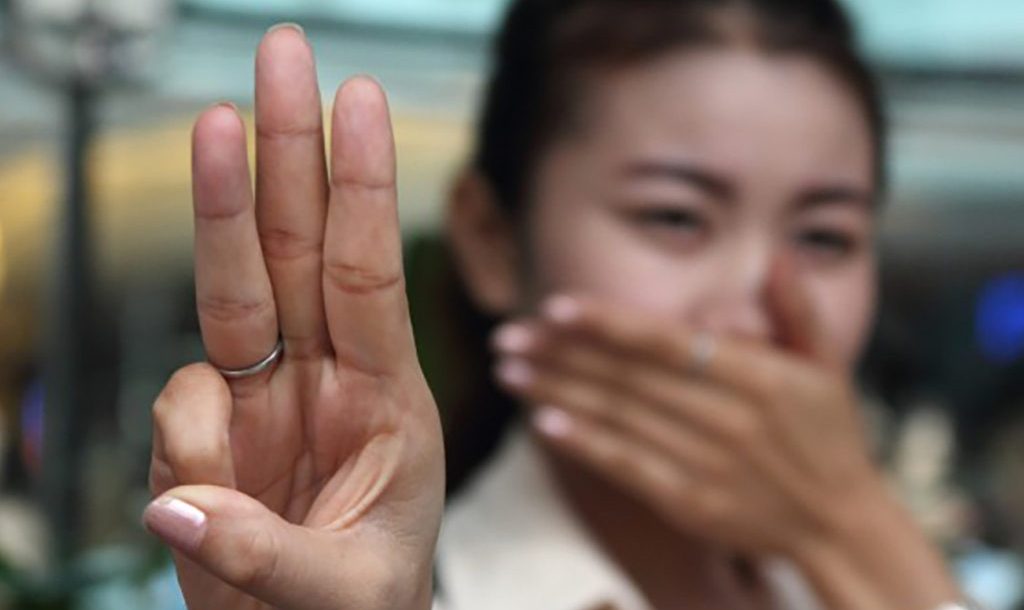Are new protest movements driven by young people enough to inspire citizens and save the country’s ever-decreasing democratic hopes?
Once upon a time, there was a land of smiles. Now, with the bleak economy, and the rising household debts of the working class, some are calling Thailand ‘the sick man of Southeast Asia.’
The political deadlock has reached the point where ordinary Thais have almost forgotten how it started in the first place. Everyday it seems, the junta introduces new, more worrisome, problems— take the Single Gateway for instance.
In terms of civil and political freedoms, Thailand’s record is abominable. The junta has silenced liberal and progressive critics – by both coercion and repression. Some of the most outspoken voices have either gone underground or into exile. Those who do not have the privilege to flee join the growing number of political prisoners now filling up prisons.
In the face of these concerns, the Thai public is being told to ‘shut up and consume,’ and leave their future in the hands of a paternalist oligarchy. Their proposed charter gives us a frightening glimpse into the society that they wish to bring about. For example, proposed cuts to free high school—replaced by pre-elementary education—redistributes state welfare to the needs of the urban middle class, at the expense of working families.
Without the freedom of speech to debate the charter, hope seems to be wanting, desperately, in the land of ‘free people.’
Over the last few months I have been living in Myanmar. There, concerned NGO and activist friends often ask me about the political situation in Thailand: am I optimistic about the political future?
Given the downward spiral we have witnessed since the military coup in May 2014, I am always tempted to offer a pessimistic outlook. Recently, however, I am inclined to give a different kind of response, one informed by new sources of inspiration.
The Thai political landscape has changed so rapidly and profoundly since Thailand’s latest coup – not to mention the previous coup in 2006 – that the counter-movement it has created is nascent and still taking form. Yet, the emergent movement – or rather, movements – of young activists has already become a source of strength for ordinary people.
I am talking about the arrival of courageous, well-organised and creative student activism led by Dao Din, Liberal League of Thammasat for Democracy (LLTD), Liberal Assembly of Chiang Mai University for Democracy (LACMUD), and the New Democracy Movement (NDM).
In my conversations with older generations of Thai activists, people often raise the concern that activists struggle to build on disparate protest events to create an organised sustained movement. This challenge is associated with the fact that, in past years, protests led by Bangkok-based activists frequently resulted in one unintended consequence: activists are singled out and turned into high profile martyrs, leaving the campaign disrupted and momentum lost.
Over the past two years, however, Thai student activists have increasingly shown that they are not only better coordinated, but also more strategic in their response to the limitations of the legal landscape.
Looking back to the days of the spontaneous ‘Hunger Games’ salute, recent actions are more effective and better conceived; especially in the way they allow broader participation with low personal risk. For instance, the series of ‘Toys, Dolls and Balloons’ protests in Bangkok, Chiang Mai, Khon Kaen, Pattani and Chiang Rai, allow people to use objects to express otherwise outlawed opinions on the country’s proposed new charter.
It would be misleading to talk about the movements without acknowledging the critical supporting role of human rights lawyers, progressive scholars and journalists, and other veteran activists. More importantly, each group in the student movement has its own strengths, approaches, and area of priorities.
For instance, the urban-based groups such as NDM are shrewd in their ability to frame campaigns around the tastes and interests of urban Thais, whereas Dao Din, recently organising under the umbrella of the New E-Saan Movement, is committed to grassroots community organising on issues that resonate in the Northeast.
While urban Thais and Northeasterners share the goal of returning democracy to the country, there remains a fundamental question in terms of how to negotiate different priorities on everything from free education to development projects.
What I have learned from the movement for democracy in Myanmar is that movements are at their most powerful when diverse groups with different priorities manage to cultivate trust and a shared collective vision. With Thai youth activists breathing new life into political activism, hope has been rekindled for the most cynical among us.
The challenge that awaits us – for both the inspired and cynical – is how we can now collectively build on the strength and diversity of the democracy movement to bring into being a shared vision inclusive of the needs and desires of the whole country.
Kriangsak Teerakowitkajorn is a Thai political economist, and trainer for social change. He is completing a PhD at the Department of Geography, Syracuse University, researching the geography of labour activism in the Thailand’s industrial estates.
 Facebook
Facebook  Twitter
Twitter  Soundcloud
Soundcloud  Youtube
Youtube  Rss
Rss 